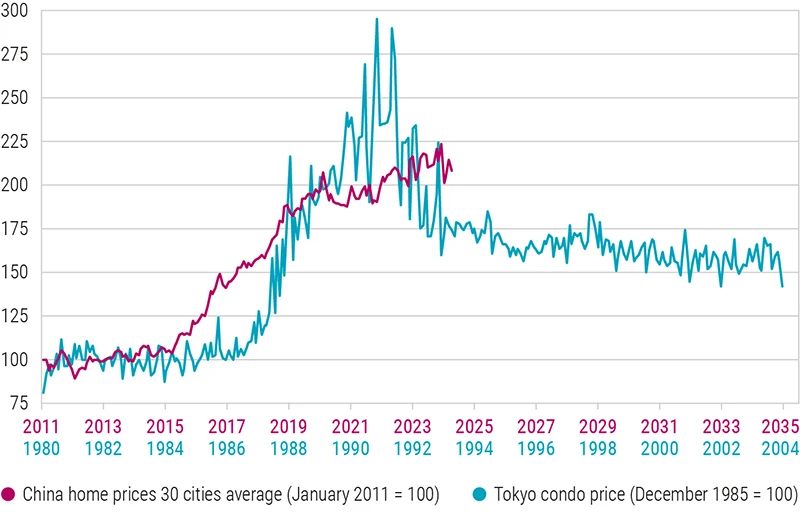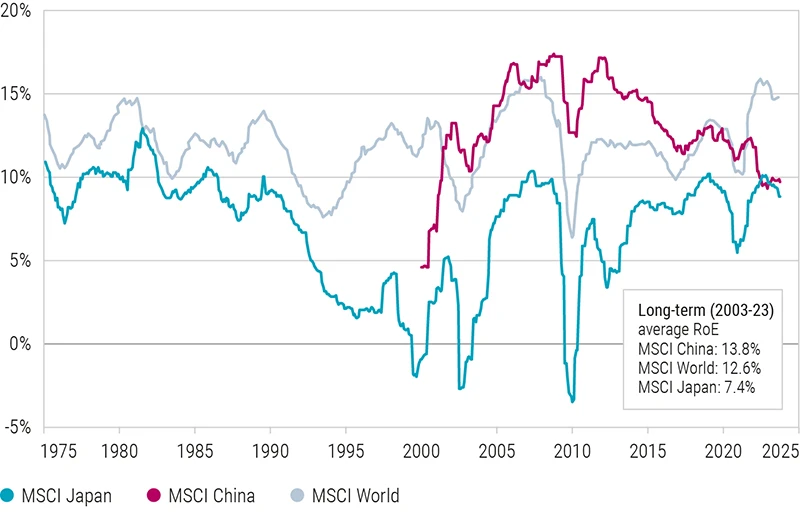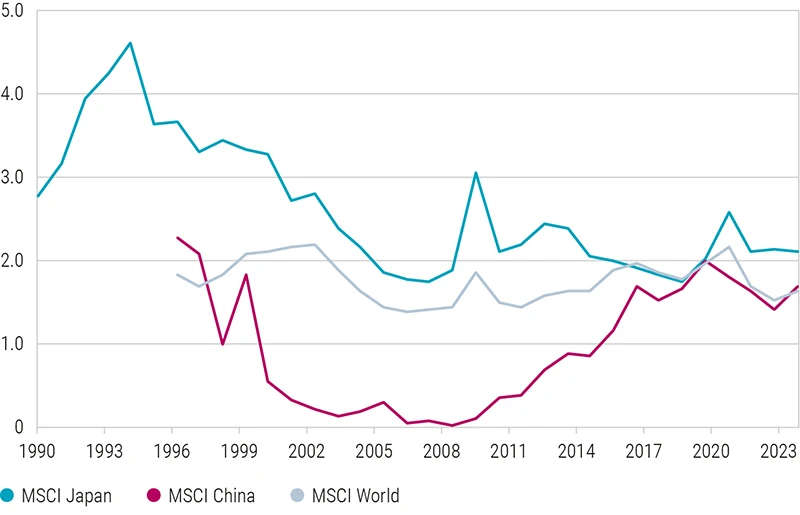Japan’s economy in the late 1980s was characterized by rapid growth and high levels of investment and the country reached a weight of 40% in the MSCI World Index before the bubble burst. It then took the Nikkei 225 nearly 35 years to surpass its December 1989 high. The bursting of the asset price bubble brought about economic stagnation and deflation. Land prices bottomed out only in 2005 and the Japanese stock market didn’t even hit rock bottom until 2012.
Is history repeating itself in China now? Some parallels are becoming increasingly apparent. In 2017, China was projected to become nearly 50% of the global emerging markets benchmark as more and more of the vibrant A-share market became accessible to foreign investors. The market lost its mojo though after the government clamped down on the all too powerful position of the internet giants. China now has ‘just’ a 24% weight in the MSCI Emerging Markets Index.
Can China regain its momentum or will it go the way of Japan with a lost generation for the economy and investors? Are we now seeing a Japanification of China?
Property market woes are not comparable
In 1980s Japan, companies used property and land to lever up and buy more commercial property or expand into other economically unviable projects. When the bubble collapsed, the corporates and the banks carried the weight of the downturn. In contrast the problems In China are in residential property, not in commercial. Many Chinese families own several properties as an investment or retirement nest egg, hoping for capital gains.
China was already aware of the risks of this activity and acted to avoid a bubble developing. Hence, prices never went up as much as during the land speculation frenzy in Japan in the 1980s. Average residential sales prices per square meter rose 7.3% annually since 2007, well below the increase in annual nominal GDP of about 12% over that same period. In Tokyo, home prices grew 13% annually, well above nominal GDP growth of about 8% in the 1980s.
Figure 1: China home prices: Never really bubbly

Source: CEIC, National Bureau of Statistics, Nomura Research Institute.
Demographics, debt, and deflation
Japan’s population peaked twenty years after the bubble burst in 2010 at 128 million and stood at 123 million in 2023. In comparison, China’s population peaked in 2021 at 1.42 billion and has shrunk slowly since then. The demographic challenge could keep the housing market subdued, as demand is likely to recede. Subsequent deflation increases the real value of debt, necessitating policy to create inflation to keep this manageable. If there ever was a time for easy monetary policy in China, it is now. Japan is generally seen as having erred in keeping monetary policy tight for too long during the early 1990s.
China has a better starting position to deal with leverage and excess capacity than Japan had, since it has more of a growth runway ahead than Japan did in the 1990s. According to IMF data, per capita income in Japan at the end of its economic miracle was 120% that of the US, while in China it stands at 16% now. Economic growth at about 5%, driven by productivity gains, means China can grow out of its problems more easily. A caveat here would be that policy-making in China is deemed to have become less pragmatic and more dogmatic which may result in suboptimal decisions.
CNY is not undervalued
US politicians claim the yuan is cheap today, but real effective exchange rate calculations show it is actually a little expensive. Even at today’s rate, the country is super-competitive and generates a trade surplus of about USD 1 trillion annually. China will not have to fight imported deflation from a rising currency. Its interest will be best served by currency stability and the yuan is unlikely to move a lot over the next five years.
ROE and equities
For long-term equity investors, return on equity (RoE) is a crucial yardstick. Considering Chinese companies’ balance sheets probably won’t be affected by the fall in property prices, they are not expected to deleverage like Japan’s corporate sector did in the 1990s. There is a risk though that many industrial companies have overinvested and will need to deal with lower margins and potential write-downs of obsolete factories in the next five years. This could cause Chinese RoE to fall, causing lackluster equity market performance. However, the gearing of Chinese corporates is average by international standards and balance sheets do not need repair via equity issuance. Many private companies have announced buybacks in response to the weakness in share prices: clear capitalist behavior that equity investors will appreciate.
Figure 2: Better RoEs in China than in Japan

Source: MSCI, Morgan Stanley research.
時刻把握我們最新市場觀點及電子報
接收荷寶電子報,率先閱讀最新洞察分析,並構建最綠色的投資組合。
Figure 3: China vs Japan net debt/EBITDA (ex-financials)

Source: MSCI, Morgan Stanley research.
Conclusion
There are three main reasons to assume China will not face the ordeal that Japan lived through. First, Chinese policy makers have been able to contain property price increases to a more manageable level. There is far less leverage in the China property market than there was in Japan.
Second, China can still grow its way out of the problem as there is plenty of room for productivity gains. Third, Chinese corporates so far seem to better understand the cost of equity and also have not been shell-shocked into a rapid de-leveraging cycle.
Chinese companies must now demonstrate they can sustain RoE in the face of overcapacity. If they can, the equity market is undervalued. Conversely, Japanese RoE is on a decisive uptrend, and if they can reach the old Chinese levels, the equity market outlook for Japan will also be bright.
This article is an excerpt of a special topic in our five-year outlook.
免責聲明
本文由荷宝海外投资基金管理(上海)有限公司(“荷宝上海”)编制, 本文内容仅供参考, 并不构成荷宝上海对任何人的购买或出售任何产品的建议、专业意见、要约、招揽或邀请。本文不应被视为对购买或出售任何投资产品的推荐或采用任何投资策略的建议。本文中的任何内容不得被视为有关法律、税务或投资方面的咨询, 也不表示任何投资或策略适合您的个人情况, 或以其他方式构成对您个人的推荐。 本文中所包含的信息和/或分析系根据荷宝上海所认为的可信渠道而获得的信息准备而成。荷宝上海不就其准确性、正确性、实用性或完整性作出任何陈述, 也不对因使用本文中的信息和/或分析而造成的损失承担任何责任。荷宝上海或其他任何关联机构及其董事、高级管理人员、员工均不对任何人因其依据本文所含信息而造成的任何直接或间接的损失或损害或任何其他后果承担责任或义务。 本文包含一些有关于未来业务、目标、管理纪律或其他方面的前瞻性陈述与预测, 这些陈述含有假设、风险和不确定性, 且是建立在截止到本文编写之日已有的信息之上。基于此, 我们不能保证这些前瞻性情况都会发生, 实际情况可能会与本文中的陈述具有一定的差别。我们不能保证本文中的统计信息在任何特定条件下都是准确、适当和完整的, 亦不能保证这些统计信息以及据以得出这些信息的假设能够反映荷宝上海可能遇到的市场条件或未来表现。本文中的信息是基于当前的市场情况, 这很有可能因随后的市场事件或其他原因而发生变化, 本文内容可能因此未反映最新情况,荷宝上海不负责更新本文, 或对本文中不准确或遗漏之信息进行纠正。
